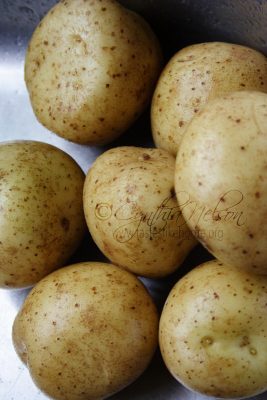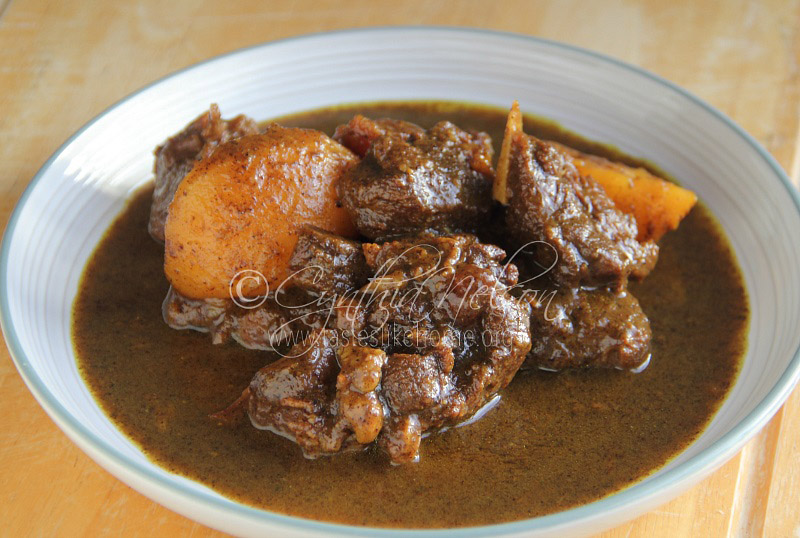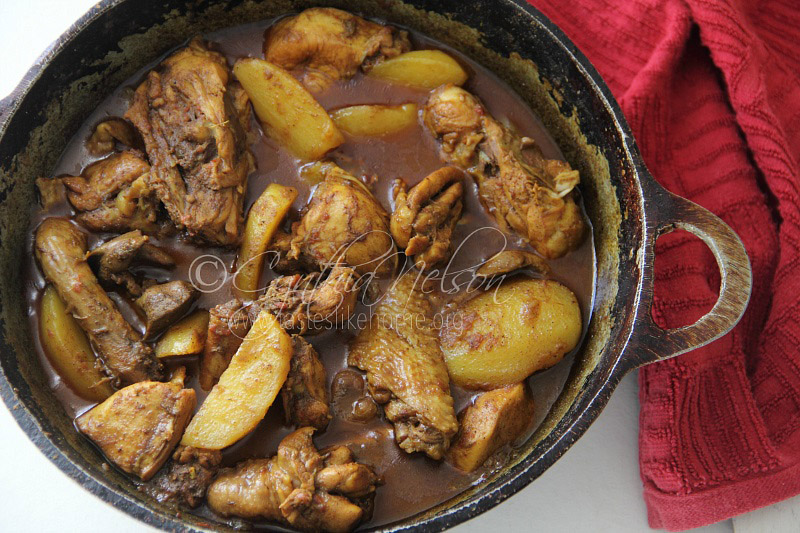Do you always put potatoes (aloo) in your meat curries, whether chicken, beef, pork or mutton? Or even fish curry? I do, except when it is a bunjal curry, meaning a dry curry. Like many of you, I’ve got to have aloo in a curry, it just makes it better. And the best part is that it will be the best tasting aloo in a curry you will ever eat. If you doubt me, try making aloo/potato curry on its own, it will simply be pleasant. Nothing to write home about.
What makes potatoes so special and delicious in a curry is that they easily absorb the flavour of the protein with which they are cooked, including the rich, spiced masala. A while back I tested my theory of potatoes in a curry – meat and meatless. Using the same masala base, I made a pan of chicken curry with potatoes and a separate pan of curried potatoes. It makes sense, but I could not believe how different the potatoes tasted – the ones cooked with the chicken were far superior in taste to the potatoes cooked alone. And when potatoes were added to beef curry, they had a very different taste from the ones cooked with chicken or fish in a curry. In each case, the potatoes readily took in the flavours of the main ingredient. Quick side note, the ability of potatoes to absorb the flavours is also a good reason to add potatoes to a curry if you have inadvertently been a little heavy with the salt. The potatoes soak up the saltiness like a sponge.
Growing up, potato in a meat curry was one of the best ways to stretch meat to feed a large family or crowd. It became such a norm that for many of us, now adults, we must have potatoes in our meat curries even if there is no need for the stretching. Sometimes we even identify the potato as part of the name of the dish, for example, Chicken Curry with Potatoes or Beef and Potato Curry. It seems important to let people know that there are potatoes in the curry. And when I think of potatoes in a curry, I prefer to use the Indian word, aloo, it somehow makes it seem more homely, comforting, proper, yet local.

Putting aloo in a curry also serves another purpose – it helps to thicken the sauce/gravy. Many home cooks will tell you how to expertly thicken the curry to make it great by mashing a couple pieces of the cooked potatoes with the back of the pot spoon by pressing and rubbing it against the side of a karahi then giving the pot a “good stir”. Apart from the mashing, during the process of cooking, potatoes release their starch which also helps to improve the texture of a curry.
Everything that is enticing and delicious about adding aloo to a curry is the same for adding potatoes to a stew. Like meat curries, meat stews benefit greatly with the addition of potatoes.
Because potatoes/aloo are such a necessary ingredient for many of us to add to curries and stews, it is important that we not add the spuds too early causing them to disintegrate and melt completely into the sauce. After all, they are added to the dish for the purpose of – you know, like when you crush the potatoes with your roti or Dhal Puri or mash it with your fingers to mix with the rice. Depending on how large you cut the potatoes, they should take about 12 – 15 minutes to finish cooking. Add the potatoes to the curry or stew based on the time you think it will take to cook. Do not simply scatter them on top, nestle them into the curry or stew between the meat and cover the pan so that the steam can circulate evenly.
I have seen people boil the potatoes and then add them to the stew or curry. Don’t do that. At this stage, the potatoes are already cooked so there is no room for the absorption of the flavour of the curry or stew except to colour the potatoes.
Speaking of potatoes… Have you noticed for the past few years that we have not been

getting good quality potatoes? Apart from the obvious signs indicating a lack of quality – cuts, blemishes, dark spots and bruises, sprouts, wrinkled skin and sometimes green skin – many of the potatoes look good to cook and eat but if you don’t do so within a day or two of buying the potatoes, they “cook up” hard with an unpleasant texture and taste. There was a time when one would buy 5 and 10 pounds of potatoes one time and have them last for a while, not so these days. I find myself only buying potatoes when I need to cook with them, often the same day or the day before. I know my age is showing here but there was a time when there were always potatoes in the basket that I could fry some aloo and corned beef or a quick meal or make a lil potato choka in the morning to eat with my sada roti. I can’t do that sort of impulsive cooking anymore.
On a recent visit up North, I made some sautéed potatoes and it was like rediscovering potatoes all over again. They cooked up quickly; they looked fantastic. I kept going on and on about how great the potatoes tasted. My host must have been thinking, “Wow, I have never heard anyone rave so much about potatoes. What’s the big deal, they’re just potatoes.” But then she tasted them. They were perfection, (her word not mine) she finally understood the power of the potato.
Cynthia







